See also
| Subdivisions |
| |||||||||||||
|---|---|---|---|---|---|---|---|---|---|---|---|---|---|---|
| Settlers and Irredentism |
| |||||||||||||
| Architecture |
| |||||||||||||
| Infrastructure |
| |||||||||||||
| Political concepts | ||||||||||||||
| Police and military |
| |||||||||||||
| Currencies and Stamps | ||||||||||||||
| Italian Pidgin of Libya | |
|---|---|
| Pidgin italiano di Libia | |
| Region | Libya |
| Era | early to late 20th century |
Italian-based pidgin | |
| Language codes | |
| ISO 639-3 | None (mis) |
| IETF | crp-LI |
Libya's Pidgin Italian is a name given to the Italian language used by the native Arabs in the North African nation of Libya. It was created in the 1920s and disappeared in the 1980s [1]
The Pidgin Italian of Libya is a legacy of Italian colonial period, when Libya was part of Italian North Africa. Of course Italian was the language of the Italians who settled in Libya. In 1940 nearly half the native Libyans were able to speak in Italian (and in Tripoli & Benghazi all of them) and many loanwords from Italian were assimilated in the local Arab language. [2] But since the 1920s started to be developed between the native Arab population a "Pidgin italian", with Arab and Italian words mixed (according to historian Tripodi [3] ).
Although it was greatly used by most of the Arab Libyans on the coast since colonial rule, the Pidgin Italian greatly declined under the rule of Muammar Gaddafi who expelled nearly all the Italian colonists population (and Italian-educated Libyans who were opposed to Gaddafi's rule). The Libyan dictator returned Arabic to be once again the sole official and common used language of the country. [4]
Under the colonial regime, Italian was the language of instruction in schools, but only a scattering of Muslim children attended these institutions. As a consequence, the Italian language did not take root in Libya to the extent that French did elsewhere in North Africa. Nevertheless, the strong wave of nationalism accompanying the 1969 revolution found expression in a campaign designed to elevate the status of the Arabic language. An order was issued requiring that all street signs, shop window notices, signboards, and traffic tickets be written in Arabic. This element of Arabization reached its apogee in 1973, when a decree was passed requiring that passports of persons seeking to enter the country contain the regular personal information in Arabic, a requirement that was strictly enforced. U.S. Library of Congress: Libya
Nonetheless, Italian and Pidgin Italian were still spoken and understood to some degree by mainly some old people until the 1980s. After the National Transitional Council (NTC) has been responsible for the transition of the administration of the governing of Libya, returning Libyan refugees from Italy or Switzerland and their children who speak Italian introduced these languages again in Libya but only in some limited cities, like in the capital Tripoli and in Benghazi.
While phonology and intonation are affected by Arabic, Libyan Italian is mostly based on the standard European form. The Italian lexicon used in Libya contains many loanwords of Arabic origin, including Islamic terms. Actually there are 682 loanwords in the dialect spoken in Tripolitania, according to Saul Hoffman. [5]
The nearly seven hundred loanwords are related to many terms of Italian origin about mechanics, especially in reference to cars and workshop work, but without excluding carpentry, building, plumbing and everything related to electricity. There follow areas such as food, clothing and medicine and then breakfast items and drink and so on up to daily domestic terms.
The following are some examples of these loanwords:
| Libyan Arabic & Libya's Pidgin Italian | Italian | ||||
|---|---|---|---|---|---|
| Word | IPA (Western) | Meaning | Word | Meaning | |
| ṣālīṭa | [sˤɑːliːtˤa] | slope | salita | up slope [6] | |
| kinšēllu | [kənʃeːlːu] | metallic gate | cancello | gate [7] | |
| anguli | [aŋɡuli] | corner | angolo | corner [8] | |
| ṭānṭa, uṭānṭa | [tˤɑːntˤɑ],[utˤɑːntˤɑ] | truck | ottanta | eighty [9] (a model of a truck of Italian make) | |
| tēsta | [teːsta] | a hit with the forehead | testa | head [10] | |
| maršabēdi | [marʃabeːdi] | sidewalk | marciapiede | sidewalk [11] | |
| calcio | [kɑːttʃu] | kick | calcio | kick [12] | |
| sbageṭi, spageṭi | [sbɑːɡeːtˤi,spɑːɡeːtˤi] | spaghetti | |||
| lazānya | [lɑːzɑːnja] | lasagna | |||
| rizoṭu | [rizoːtˤu] | risotto | |||
| feṭuččini | [fetˤutˤ.ʃiːni] | fettuccine | |||
| kuğīna | [ku.dʒiːna] | kitchen | cucina | ||
Also, Libyan Italian can be seen to resemble the form and structure of Creole-based forms of European languages.
Actually some loanwords from the Italian language have been fully assimilated into the Libyan Arab language. [13]
Maltese is a Semitic language derived from late medieval Sicilian Arabic with Romance superstrata spoken by the Maltese people. It is the national language of Malta and the only official Semitic and Afroasiatic language of the European Union. Maltese is a Latinized variety of spoken historical Arabic through its descent from Siculo-Arabic, which developed as a Maghrebi Arabic dialect in the Emirate of Sicily between 831 and 1091. As a result of the Norman invasion of Malta and the subsequent re-Christianization of the islands, Maltese evolved independently of Classical Arabic in a gradual process of latinization. It is therefore exceptional as a variety of historical Arabic that has no diglossic relationship with Classical or Modern Standard Arabic. Maltese is thus classified separately from the 30 varieties constituting the modern Arabic macrolanguage. Maltese is also distinguished from Arabic and other Semitic languages since its morphology has been deeply influenced by Romance languages, namely Italian and Sicilian.
The Maltese alphabet is based on the Latin alphabet with the addition of some letters with diacritic marks and digraphs. It is used to write the Maltese language, which evolved from the otherwise extinct Siculo-Arabic dialect, as a result of 800 years of independent development. It contains 30 letters: 24 consonants and 6 vowels.
Libyan Arabic, also called Sulaimitian Arabic by scholars, is a variety of Arabic spoken in Libya, and neighboring countries. It can be divided into two major dialect areas; the eastern centred in Benghazi and Bayda, and the western centred in Tripoli and Misrata. The Eastern variety extends beyond the borders to the east and share the same dialect with far Western Egypt, Western Egyptian Bedawi Arabic, with between 90,000 and 474,000 speakers in Egypt. A distinctive southern variety, centered on Sabha, also exists and is more akin to the western variety. Another Southern dialect is also shared along the borders with Niger with 12,900 speakers in Niger as of 2021.
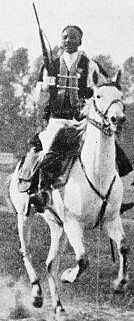
Savari was the designation given to the regular native Libyan cavalry regiments of the Italian colonial army from 1912 to 1943, in Italian Tripolitania and Italian Cyrenaica, and later in Italian Libya. The word "savari" was derived from a Persian term for "horsemen" (Savārān).

The Italian colonizationof Libya began in 1911 and it lasted until 1943. The country, which was previously an Ottoman possession, was occupied by Italy in 1911 after the Italo-Turkish War, which resulted in the establishment of two colonies: Italian Tripolitania and Italian Cyrenaica. In 1934, the two colonies were merged into one colony which was named the colony of Italian Libya. In 1937, this colony was divided into four provinces, and in 1939, the coastal provinces became a part of metropolitan Italy. The colonization lasted until Libya's occupation by Allied forces in 1943, but it was not until the 1947 Paris Peace Treaty that Italy officially renounced all of its claims to Libya's territory.

Italian profanity are profanities that are blasphemous or inflammatory in the Italian language.

Libya was a colony of Fascist Italy located in North Africa, in what is now modern Libya, between 1934 and 1943. It was formed from the unification of the colonies of Cyrenaica and Tripolitania, which had been Italian possessions since 1911.

Italian Tripolitania was an Italian colony, located in present-day western Libya, that existed from 1911 to 1934. It was part of the territory conquered from the Ottoman Empire after the Italo-Turkish War in 1911. Italian Tripolitania included the western northern half of Libya, with Tripoli as its main city. In 1934, it was unified with Italian Cyrenaica in the colony of Italian Libya. In 1939, Tripolitania was considered a part of the Kingdom of Italy's 4th Shore.

The Libyan Coastal Highway, formerly the Litoranea Balbo, is a highway that is the only major road that runs along the entire east-west length of the Libyan Mediterranean coastline. It is a section in the Cairo–Dakar Highway #1 in the Trans-African Highway system of the African Union, Arab Maghreb Union and others.

Italy–Libya relations are the bilateral relations between the State of Libya and the Italian Republic. Italy has an embassy in Libya's capital, Tripoli, and a general consulate in Benghazi. Libya has an embassy in Italy's capital, Rome, and two general consulates.
Arab Lictor Youth was a fascist youth organization for Arab youth in Italian Libya.

This is a survey of the postage stamps and postal history of Libya. Libya is a country located in North Africa. Bordering the Mediterranean Sea to the north, Libya lies between Egypt to the east, Sudan to the southeast, Chad and Niger to the south, and Algeria and Tunisia to the west.
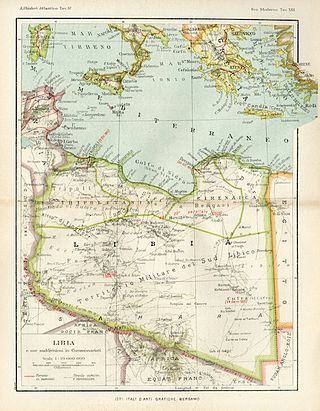
Benghazi Province, or Provincia di Bengasi in Italian, was one of the provinces of Libya under Italian rule. It was established in 1937.

The Royal Corps of Colonial Troops was a corps of the Royal Italian Army, in which all the Italian colonial troops were grouped until the end of World War II in North Africa campaign.

The Italian refugees from Libya were the Italian settlers and their descendants who were forced out of Libya after the end of WWII. Most took refuge in Italy, mainly after their expulsion in 1970, ordered by Muammar Gaddafi.
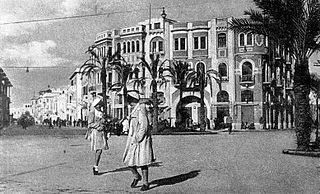
Italian Benghazi was the name used during the Italian colonization of Libya for the port-city of Benghazi in Italian Cyrenaica.
Italian Pidgin in Eritrea was a pidgin language used in Italian Eritrea when Eritrea was a colony of Italy.
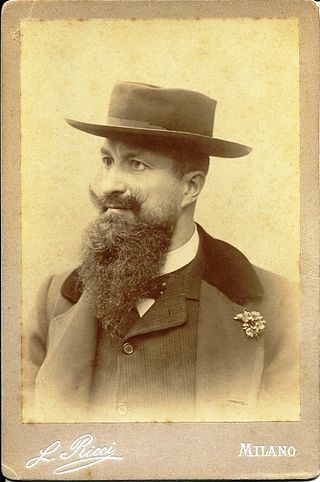
Luigi Robecchi Bricchetti was an Italian explorer, geographer, cartographer and naturalist.
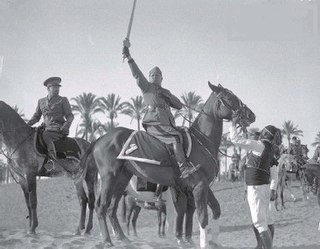
The Sword of Islam was a ceremonial weapon given in 1937 to Benito Mussolini, who was pronounced as the Protector of Islam.